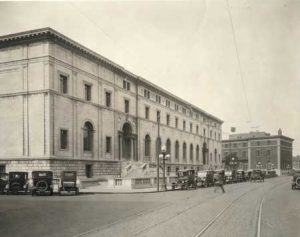Saint Paul Public Library History
The Saint Paul Public Library traces its earliest beginnings to 1856 when the newly formed Young Men's Christian Association opened a reading room. The following year, both the Saint Paul Library Association and the Mercantile Library Association also were organized. These early efforts all merged in 1863 into the Saint Paul Library Association.
In 1879, under the leadership of Alexander Ramsey (who had served as Mayor, Governor, U.S. Senator, and U.S. Secretary of War), the Library Association proposed that the City accept responsibility for their collections and establish it as a free public library. Finally, on September 7, 1882, the city council approved an appropriation of $5,000 to establish the Saint Paul Public Library. By this date, the collection had grown to include 8,051 books.
In the following years, the Library grew rapidly. As early as 1890, there were calls for the construction of a new building. In 1900, the Library moved to the old Market Hall, located on Seventh Street. Many civic leaders continued to push for the construction of a new building, but the Library remained in the Market Hall until a fire in 1915 destroyed the entire building, including the Library and most of its collection of 158,000 books. Fortunately, construction of the new Central Library was already underway.
Planning for the new Central Library had occurred well before the 1915 fire. Under the leadership of Mayor Lawler in 1909, serious work began on building a new Library. A site was chosen on Rice Park, and in 1910, the Library board began discussing how to raise the $500,000 it was estimated the new building would cost.
By 1912, railroad baron James J. Hill had offered to contribute $700,000 specifically for the construction and endowment of a reference library attached to the public library. Almost simultaneously, $100,000 toward the project was raised through a subscription campaign, $30,000 was received through a bequest from Greenleaf Clark, and the state legislature authorized the sale of $600,000 in bonds for the construction of the new facility. By the fall of 1912, the Library board had hired Charles Soule, a Boston library consultant, to assist in planning the new facility. Ground was broken for Central Library in 1914. Ultimately, the entire building, including the James J. Hill Reference Library, was erected at a cost of approximately $1.5 million.
In the years since then, Saint Paul Public Library has grown and evolved to fit the changing face of Saint Paul and the world around it. Branch libraries have become integral parts of the neighborhoods around them, serving as community centers and in many ways reflecting the needs and values of that community.
One milestone for the Library came in 1945, with the establishment of The Friends of the Saint Paul Public Library. Through the years, the Friends has grown to become a key partner with the City in the provision of library service, through fundraising, programming and advocacy. The Friends is now nationally recognized as one of the best library support organizations in the nation.
Today, the Saint Paul Public Library system consists of the George Latimer Central Library, 12 branches, and a mobile library.
Many things have changed but the basic service: that of providing information and ideas to realize dreams and spark the imagination, remains the same.

